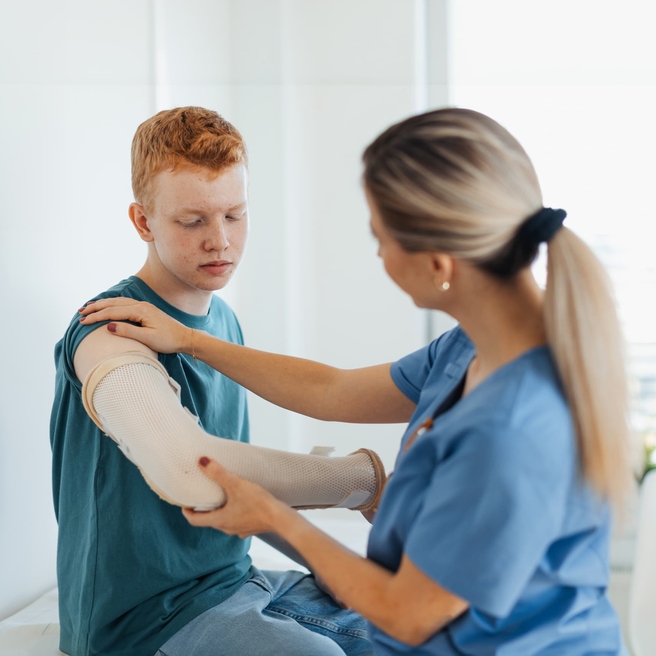What is osteochondritis dissecans?
Osteochondritis dissecans (OCD) is a condition in which a portion of bone or cartilage separates (either partially or completely) from the surface of the joint and creates pain, swelling and sometimes a locking sensation. OCD most often affects the knee, but the elbow and ankle can also be affected. Lesions have been reported in other parts of the body, too.
The condition got its name from what happens in a case of OCD: osteo (bone), chondrus (cartilage), itis (inflammation) and dissecans (to separate).
Causes of osteochondritis dissecans
While the exact cause of osteochondritis dissecans is unknown, several factors appear to play a role in determining which children may be affected.
OCD may stem from:
- Repetitive use and trauma of the affected joint
- Slightly decreased blood supply in some locations
- Other genetic factors
Signs and symptoms of osteochondritis dissecans
Symptoms of osteochondritis dissecans can vary from child to child, and can change in intensity within one child with the disorder.
The most common symptoms of osteochondritis dissecans include:
- Pain and swelling
- Locking or "catching" of the affected joint or area of the body
- Increased pain with activity
- A "giving way" sensation in the affected area
Testing and diagnosis of osteochondritis dissecans
At Children's Hospital of Philadelphia (CHOP), osteochondritis dissecans is treated by orthopedic and sports medicine physicians who specialize in diagnosing and treating bone and muscle injuries in children, teens and young adults.
Our expert doctors will examine your child, assess his pain, learn about your child's medical history and perform diagnostic imaging — such as X-rays, MRIs and CT scans — to evaluate the problem.
Treatment for osteochondritis dissecans
The first step in treating OCD of the knee, elbow, or ankle is to modify your child's activities. Your child may need to temporarily change his sport or stop all activity in it.
Our multidisciplinary team will design a customized treatment program for your child that may include non-surgical options such as:
- Hard or soft cast to immobilize the bone/joint
- Weight-bearing or protected weight-bearing exercises
If non-operative treatment doesn't produce the desired effect — easing pain and allowing the bone to heal — surgical intervention may be necessary.
If surgery is needed, our world-renowned orthopedic surgeons will:
- Secure or remove a loose piece of the bone
- Stimulate new bone formation
Follow-up care for osteochondritis dissecans
Your child with OCD injuries should continue to be monitored periodically by a physician.
If your child had surgery, he will need to see the orthopedic surgeon about one to two weeks after surgery, then again at three and six months post-surgery. After that, annual monitoring by trained clinicians is strongly encouraged to ensure any problems are spotted and treated as soon as possible.
During follow-up visits, X-rays and other diagnostic testing may be done. The goal of continued monitoring is to help spot any irregularities in growth or development and to address health issues as they develop.
Follow-up care and ongoing support and services are available throughout our CHOP Care Network. Our team is committed to partnering with parents and referring physicians to provide the most current, comprehensive and specialized care possible for your child.

Why choose CHOP
We have more specially trained sports medicine physicians, orthopedic surgeons, physical therapists and athletic trainers than any other pediatric orthopedic facility in the region.
Resources to help
Sports Medicine and Performance Center Resources
We have created resources—including patient and family educational materials, videos, and more—to help you find answers to your questions and feel confident about the care you are providing your child.
